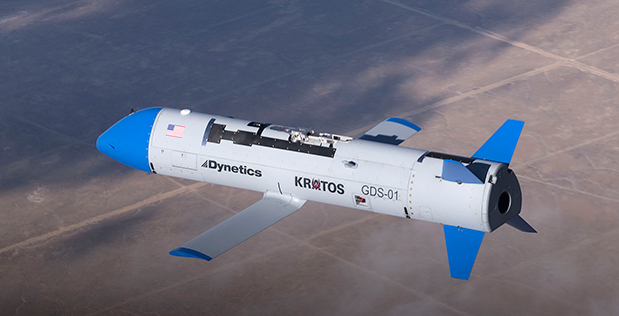Dynetics and the Defense Advanced Research Projects Agency are moving forward with their Gremlins drone swarming program after flying a small unmanned aircraft for the first time in late November.
The X-61A flew with and launched from a C-130 wing at Dugway Proving Ground, Utah. This first airborne test demonstrated some basic capabilities, like transitioning to stable, powered flight, deploying a mechanical arm from the C-130 where the drones can dock, and connecting to data links.
November’s test gives the team confidence that the Kratos Defense-built X-61A will fly where and how it’s supposed to, Dynetics Program Manager Tim Keeter told reporters Jan. 21. The flight was delayed by earthquake damage at Naval Air Weapons Station China Lake, Calif., earlier in 2019.
“The X-61A flew as predicted with no anomalies, achieving all test objectives that relate to the operational system,” Dynetics said in a release. “At the end of the mission, the engine was shut down and a drogue chute successfully deployed to terminate flight.”
When trying to recover the X-61A on the ground, however, the larger, main parachute suffered a mechanical failure, and the unmanned aerial vehicle crashed on the ground. The parachute isn’t expected to be part of the final design, but the team is still addressing the problem. Four UAVs are still usable.
At the end of the Gremlins program, Dynetics hopes to fly and recover four drones in fewer than 30 minutes. The company wants its aircraft to be able to loiter for one hour in a 300 nautical mile radius, and to carry more than 50 pounds of payloads in its nose cone. Those requirements could change—such as needing a faster UAV—when the military takes the program further.
DARPA wants to prove the program can launch and recover “volley quantities”—perhaps a dozen or more—of comparatively cheap, reusable unmanned aircraft. Once the military services pick Gremlins up as a formal program, they can experiment with using the swarm for specific missions, like coordinated attacks or intelligence, surveillance, and reconnaissance.
The next airborne test is scheduled for this spring, when the team will show whether the mechanical docking arm can retrieve and stow the UAV in flight, DARPA Program Manager Scott Wierzbanowski said.
Ideally, the X-61A will first travel under the C-130’s wake without being knocked off course. Then, the UAV will dock with a “bullet” attached to a cable that reels into the mechanical arm, which pulls the powered-down aircraft through the wake and into the C-130. People onboard the C-130 would stow the drone and send the retrieval system down for others.
“We’re working with the Air Force and the Navy to continue on with follow-on demonstrations and experimentations, and if it looks like we’re going down that path, then that is one of my No. 1 objectives, is to buy one, if not two additional Gremlins air vehicles so that we can satisfy whatever the requirements are of those missions,” like getting the drones to fly together with different weapons and sensors, Wierzbanowski said.
